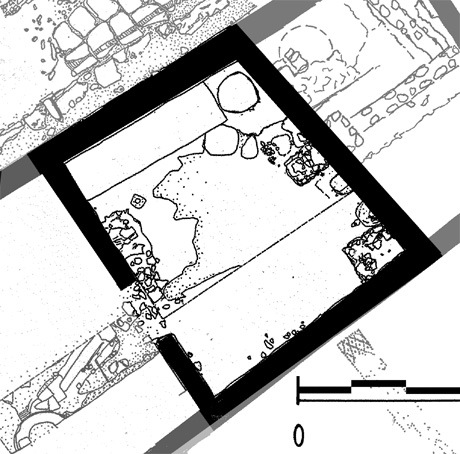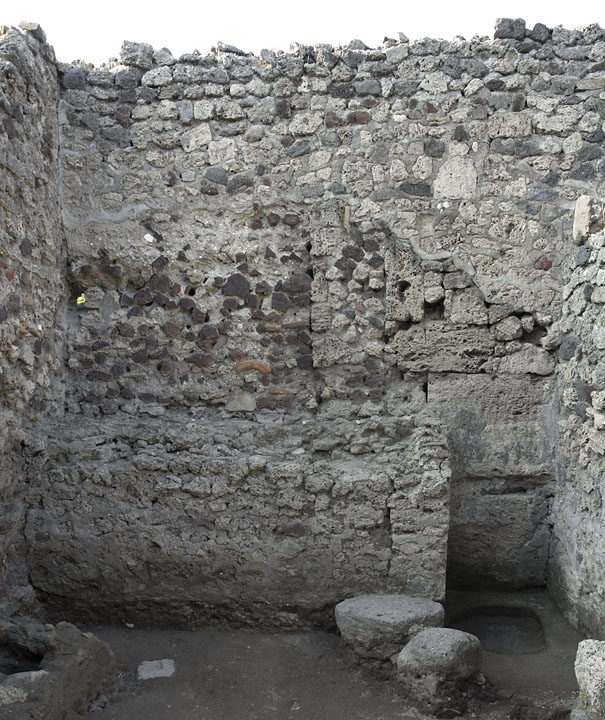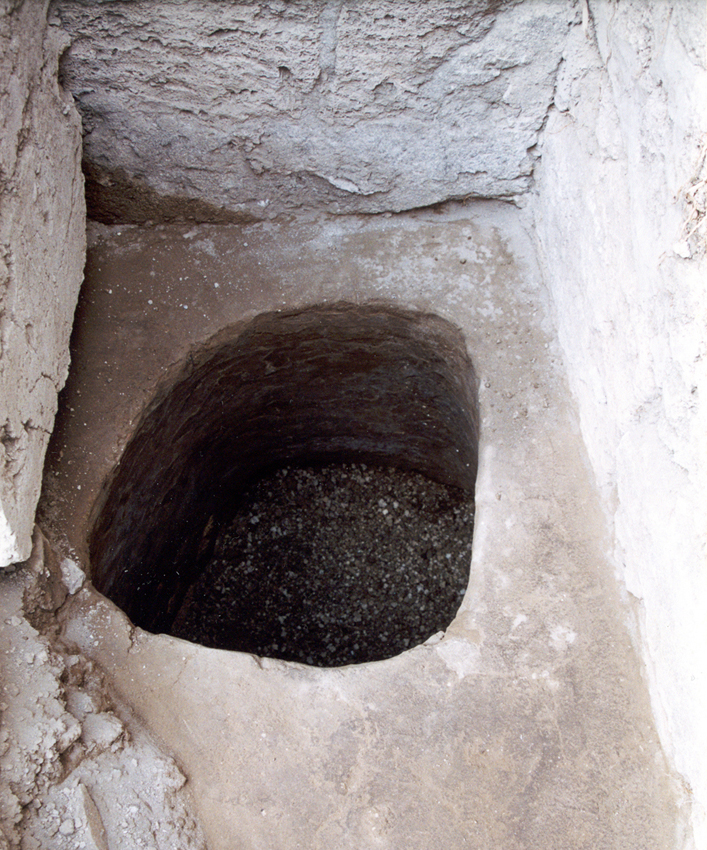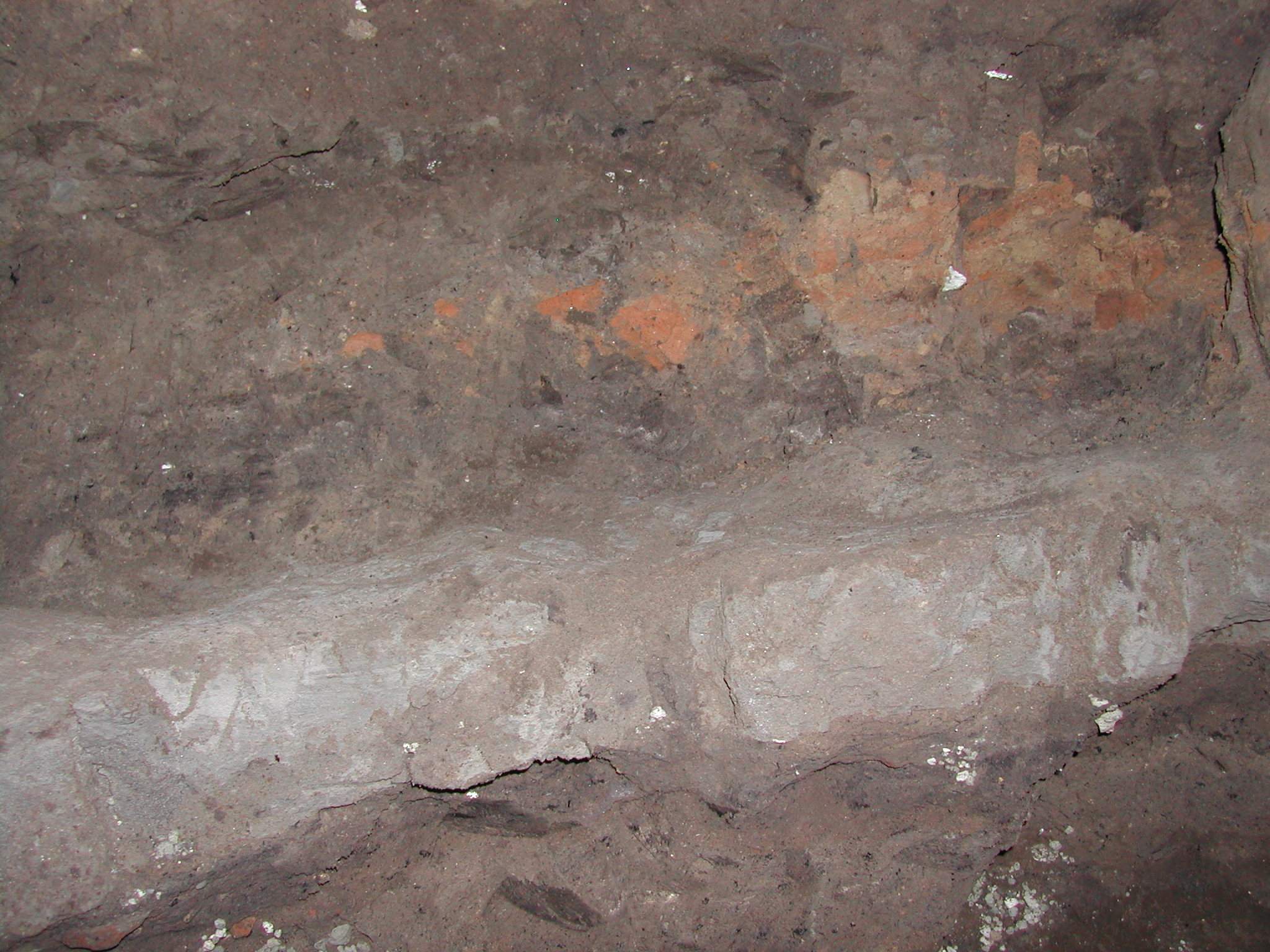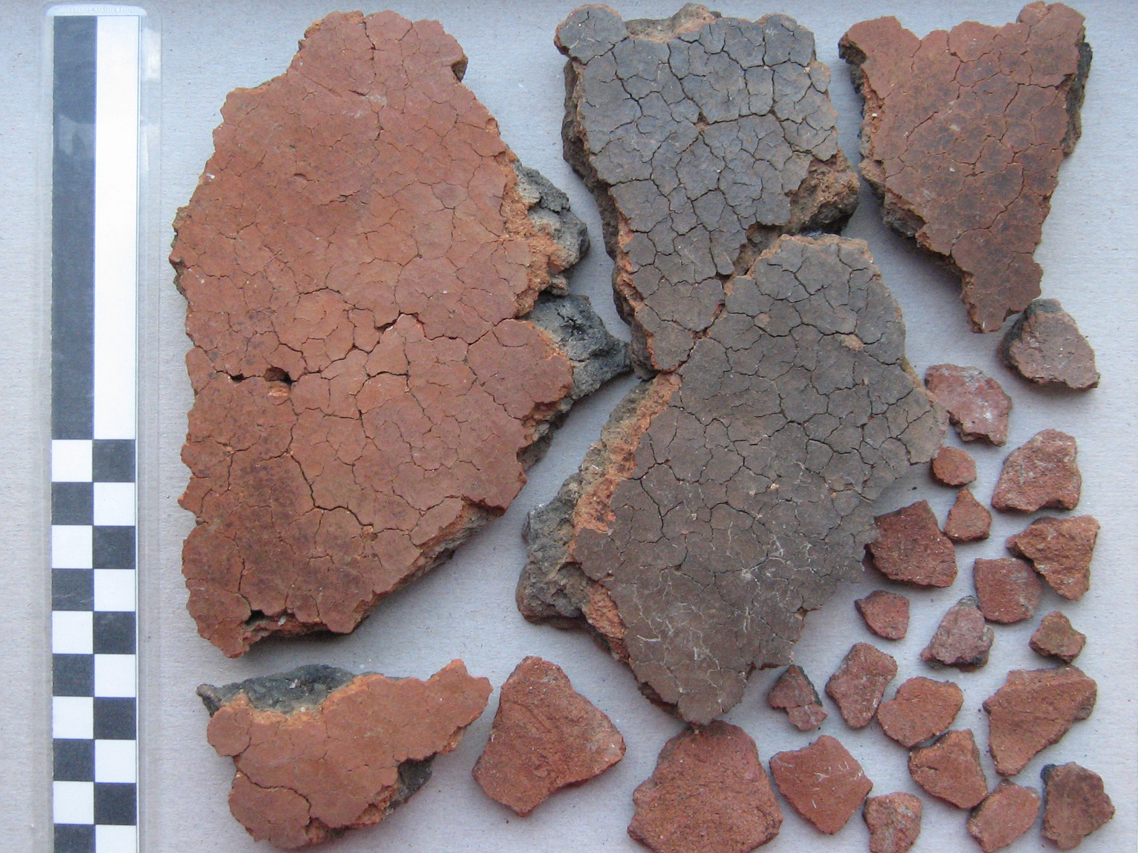Well
Description
Henrik Boman & Monika Nilsson
Roman well with a stratigraphy of Early Bronze Age layers inside
Prehistoric pottery was a chance find from the interior of a well with collapsed wall lining. In the stratigraphy of the soil, a hard, c. 0.10m thick, grey layer was encountered at c. 1.60m depth from the mouth of the well. Both above and below, charred matter and prehistoric pottery were found in rather uneven layers sloping abruptly towards the SW. To begin with, there was much discussion on the interpretation of the grey layer and the identification of the pottery, but it was concluded that we had found Palma Campania pottery on both sides of a solidified volcanic ash layer.
The well
While cleaning the area in the NE corner of room f, a concentration of pumice of the AD 79 eruption appeared. Further investigation unveiled the plaster-lined mouth of a well. It had obviously been out of use by the time of the eruption since the mouth was somewhat under the foundation of the large, built hearth next to it. It was also deduced that the reason for the concentration of pumice was that the empty well had been sealed with wood, which either during or after the eruption dissolved. The empty space then filled up with pumice, which is easily set in motion. The well was excavated down to four metres below floor level, before work was interrupted, and throughout the excavation the contents were composed of principally pumice with a few man-made finds and animal bones, especially at the top. Only in the upper part was the lining of the well preserved. From approximately 0.80m down, the plastered wall of the well had fallen off, exposing the stratigraphy of the natural soil. The shaft of the well had in the undamaged part, near the top, a diameter of 0.75m, but opened up to a diameter of 1.55m at the level of the prehistoric finds.
Roman finds at the mouth of the well
Pottery: Next to the opening of the well were several large, joining fragments of a few vessels, notably one charred plate and one (wall?) painter’s pot with green pigment generously preserved on both exterior and interior.
Bones: A concentration of numerous small rodent’s bones indicated a rat’s nest with at least four very young rats, although the size of the collected bones renders a full analysis difficult. (Incidentally, since work was carried out outdoors, the bag containing the bones could not be opened for the risk of all bones being caught in the breeze.) The nest was close to the painter’s pot. (Analysis by C. Liebe-Harkort)
Miscellaneous: A number of oxidized iron nails - probably from the wooden cover of the well - were found. Most of them are attached to pumice, perhaps a consequence of the materials coming in contact with each other at the time of the eruption. Three lamp fragments were also collected.
Roman finds inside the well
Pottery: Diagnostic pottery was collected and included a varied collection of handles. Numerous amphora fragments seemed to originate from the same container. The results of the pottery analysis are pending.
Bones: The animal bones included adult cattle, young pig, young sheep, juvenile cat, bird, fish, unidentified larger mammal and unidentified smaller mammal. The bird bones - beak, claw and phalanx, i.e. often refuse parts in cooking - belong to domestic fowl. Several of the pig bones (probably from one individual) had cut marks and one cattle vertebra had both cut marks and signs of eburnation, a degeneration in the bone, in this case probably caused by physical stress. No. of bones: 36; weight: 0.30 kg. (Analysis by C. Liebe-Harkort)
Miscellaneous: The fragment of a polished bone pin, part of a glass container, one bivalve sea shell and one terracotta loom weight with stamp at the top were collected. The most common finds, however, were architectural; broken pieces of painted wall plaster and roof tile ended up in the well at the same time the pumice did, i.e. during or slightly after the disaster. The roof tiles included both flat and rounded pieces and attached to them was a clay with small lime-pellets for joining them together on the roof.
Prehistoric finds above ash layer
Depending on which direction you turn to, the mottled - grey to orange - soil layer is from 0.06 to 0.30m in depth, with the thicker side to the north. The most conspicuous characteristic of the layer are the patches of bright orange soil or clay, but the soil is also full of small charred specks.
Pottery: 56 pottery fragments were collected from the wall of the shaft. The diagnostic sherds include one black strap handle and proportionally many rim fragments of varied types. The pottery that facilitated the identification of the Palma Campania culture (local variety of Early Bronze Age material) was the type of open vessel that has indentations along the rim and vertical plastic "knobs" for decoration.
Bones: Three bones of sheep/goat were identified and one of them showed traces of fire. The remaining two bones belonged to one larger/smaller and one smaller mammal; the former of the two appears to have been polished.
No. of bones: 5; weight: 0.01 kg. (Analysis by C. Liebe-Harkort)
Soil sample: 12 litres of soil from this context was used for water flotation. Of the rich material of charred plants, the glumes of hulled wheat, including Triticum dicoccum (emmer wheat) are most frequent. Grain of Triticum dicoccum and Hordeum vulgare (hulled six-row barley), together with seeds from Vitis Vinifera (grape) were identified. The soil also contained very eroded, small fragments of marine molluscs and bones of fish, sheep and possibly goat. Three carbon samples were used for radiocarbon dating, but the results were inconclusive. (Analysis by M. Robinson)
Volcanic ash layer
The light grey, hard layer which contains neither finds nor inclusions, was originally the fine ash of a volcanic eruption. The so-called Avellino eruption of Vesuvius is known to have laid waste large parts of the Campanian landscape at the end of the Early Bronze Age. At an Early Bronze Age cemetery excavated in modern Pompeii, the stratum with graves is sealed with an ash layer of the same thickness as here and since it was identified as the layer of the Avellino eruption, so did we make the same identification (Mastroroberto 1998). Robinson, however, did tephra analyses and is positive the ash is from Campi Phlegrei (Robinson 2008).
Prehistoric finds below ash layer
Below the ashes is a greyish brown layer, approximately 0.20m thick, speckled with small charcoal. At some points, 0.02m down from the ash layer, a thin line can be traced of what looks like sand. The finds from the excavation in Vicolo delle Nozze d’Argento indicated a close vicinity to water, probably the coast line, in the pre-eruption levels. It is therefore possible that the line represents a flooding, conceivably in connection with a seismic event that drastically changed the inclination of the ground.
Pottery: 39 pottery fragments were collected and, although some of them are quite big, they are all in a more fragile condition than those found above the ash layer. The interior of the large containers is mottled and the exterior surface is cracked. The impression is that these pots have suffered from secondary burning. Diagnostic sherds were few, but one body sherd is from a red burnished carinated cup.
Miscellaneous: No bones were encountered at all, but the single faunal find was a bivalve sea shell, Arca noae (Noah’s ark shell). It is notable that it was in the layer below the stratum of ash, as were most shells from the excavation in Vicolo delle Nozze d’Argento.
Results
For the first time in ancient Pompeii a stratigraphy with prehistoric layers was exposed and investigated. The finds were spectacular, showing an Early Bronze Age settlement at the site of ancient Pompeii, disrupted by a volcanic eruption, but not destroyed.
____________________________________
Results of radiocarbon dating of post-eruption layer
(Robinson 2008: 126)
Sample 1: 3651-3519 cal. BC
Sample 2: 3642-3382 cal. BC
Sample 3: 1890-1690 cal. BC
Only the third result can be related to the Palma Campania culture since the first two place the find well back in the Neolithic period.
____________________________________
Stratigraphy in well
(Interpreted and analysed by Mark Robinson:)
1. Roman plaster lining. Depth 0.78m.
2. Unbedded greenish-grey volcanic ash (gritty sandy loam) with grey lapilli pumice up to 5mm. Depth 0.40m.
3. Very dark silt loam with some charcoal and wood ash. Depth 0.25m.
4. Mixed red silt loam with pale grey wood ash, charcoal, plant fragments and pottery. Depth 0.22m.
5. Grey tuff of hardened fine volcanic ash. Depth 0.09m.
6. Dark brown silt loam with charcoal and pottery. Depth 0.02m.
7. Dark brown silt loam with some white lapilli pumice up to 10mm. Depth 0.33m visible during sampling. Excavation continued further down.
____________________________________
Bibliography:
H. Boman & M. Nilsson, ’The commercial establishments V 1,13; V 1,14-16; V 1,20-21: preliminary report 2001-2004’, OpRom 31-32, 2006-2007, 139-154.
M. Mastroroberto, ’La necropoli di S. Abbondio: una comunità dell´età del Bronzo a Pompei’, Archeologia e vulcanologia in Campania, Atti del Convegno, Pompei, 21 Dicembre 1996, (eds.) P.G. Guzzo & R. Peroni, Napoli 1998, 135-149.
M. Nilsson, ’Evidence of Palma Campania settlement at Pompeii’, Nuove ricerche archeologiche nell’area vesuviana (scavi 2003-2006) Atti del convegno internazionale, Roma 1-3 febbraio 2007, (eds.) P.G. Guzzo & M.P. Guidobaldi, Rome 2008, 81-86.
M. Nilsson, ’The first of a series of disasters? Pompeii and the aftermath of an Early Bronze Age eruption’, Beyond determinism? Engagement and response in human-environment interactions (Archaeological Review from Cambridge, 24.2), (eds.) R.H. Inglis & A.J.E. Pryor, Cambridge 2009, 81-98.
M. Nilsson & M. Robinson, ’Remains of prehistoric habitation beneath Pompeii V 1,13’, OpRom 30, 2005, 97-103.
M. Robinson, ’La stratigrafia nello studio dell’archeologia preistorica e proistorica Pompei’, Nuove ricerche archeologiche nell’area vesuviana (scavi 2003-2006) Atti del convegno internazionale, Roma 1-3 febbraio 2007, (eds.) P.G. Guzzo & M.P. Guidobaldi, Rome 2008, 125-138.

